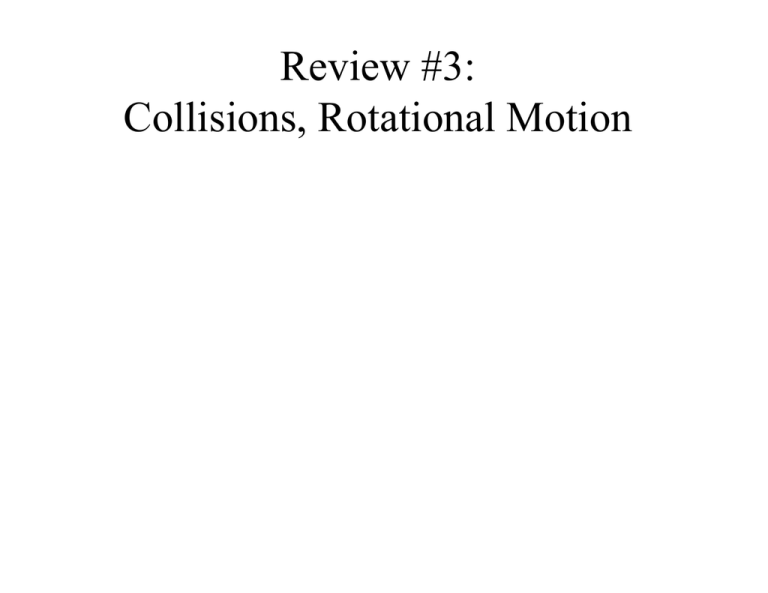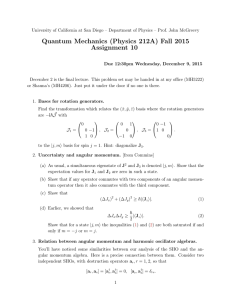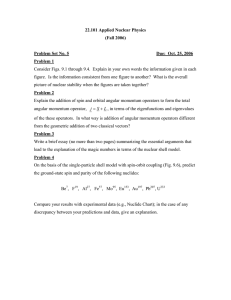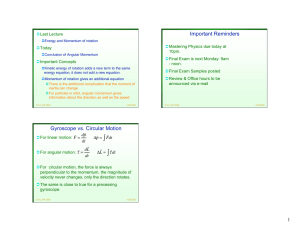Document 13605685
advertisement

Review #3: Collisions, Rotational Motion Momentum - Model From Principia: Momentum is defined as “the quantity of motion, conjointly proportional to the mass and the velocity”. momentum is for a system of particles system r r definition ---p = m v ∑ i i i momentum is sum of individual momenta Dynamics (change) of momentum - from F=ma r system forces r dp = ∑ Fi external dt i =1 Only external (through system barrier) forces ! Strategies: Momentum and External Forces 1. Identify all forces acting on the masses 2. Select your system (make troublesome forces into internal forces; make ΣFext = 0) 3. ΣFext = 0 implies momentum is conserved 4. If there is a non-zero total external force: r system forces r dp external = ∑ Fi dt i Strategy - Impulse Impulse most useful when time is short, simplifying the momentum change during the short time ∆t. A. One large external force dominates ∆p: •Ball bouncing on floor - ignore gravity B. Finite Fext for very short ∆t --> ∆psystem = 0 •Colliding cars - ignore horizontal friction •Gun and Bullet - ignore external forces Collisions: Momentum Conserved When the total external force on the colliding particles is much smaller than the internal forces, the collision duration is so short that the impulse on the system is approximately zero. Then the total initial momentum of the colliding particles equals their final momentum: r total r total p f = p0 Gives one equation each for x, y, and z Elastic Collisions • Kinetic Energy does not change. K0 total = Kf total 1 1 1 1 2 2 2 m1v1,0 + m2 v2,0 + ... = m1v1, f + m2 v2, f 2 + ... 2 2 2 2 • Momentum conserved also Rotation and Translation of Rigid Body Motion of a thrown object Translational Motion of the Center of Mass • Total momentum r r total total p = m V cm • External force and acceleration of center of mass r r total r r total dp total dV total cm F ext = =m = m A cm dt dt Rotation and Translation of Rigid Body • Torque produces angular acceleration about center of mass torques ∑τ • I cm cm,i = I cmα cm i is the moment of inertial about the center of mass • α is the angular acceleration about center of mass or any other point in a rigid body. • This is really a vector relation; only z-component is non-zero if problem is planar Fixed Axis Rotation: Kinematics Angle variable θ Angular velocity dθ ω≡ dt Angular acceleration d 2θ α≡ 2 dt These are exactly analogous to the variables x, vx, and ax for One dimensional motion, and obey the same equations For constant angular acceleration: Fixed Axis Rotation: Tangential Velocity and Tangential Acceleration Kinematics of individual mass elements: ∆mi • Tangential velocity • Tangential acceleration • Radial Acceleration vtan,i = r⊥ ,iω atan,i = r⊥ ,iα arad ,i = v 2 tan,i r⊥ ,i = r⊥ ,iω 2 PRS: Ladybug Acceleration A ladybug sits at the outer edge of a merry-go-round that is turning and slowing down. The tangential component of the ladybug's (Cartesian) acceleration is QuickTime™ and a Graphics decompressor are needed to see this picture. 1. in the +x direction. 2. 3. 4. 5. in the -x direction. in the +y direction. in the -y direction. in the +z direction. 6. 7. in the -z direction. zero. Torque Torque about axis S: r r τ S ,i = r S ,i × Fi r • Counterclockwise +z direction • perpendicular to the plane τ S ,i = rS ⊥,i Ftan,i = rS ⊥,i ∆mi a y = ∆mi (rS ⊥,i ) α 2 torques ∑τ i S ,i = I Sα cm = I Sα S Energy of Rotating Mass The mass is rotating: Angular velocity ω Radius R v R ω Speed v Speed v = ω R Kinetic Energy = 1/2 m v^2 = 1/2 m R2ω2 = 1/2 Is ω2 K rot S 1 2 = I Sω S 2 Moment of Inertia - Idea Mass element ∆mi Radius of orbit r⊥ ,i i= N Moment of Inertia about S I S = ∑ ∆mi (rS ⊥ ,i )2 S i =1 The moment of inertia takes the place of mass in the Dynamical (F=ma) and Energy (K=mv2/2) equations for rotational motion. torques ∑τ i S ,i = I Sα cm K rot S 1 2 = I Sω S 2 These work about ANY NON-ACCELERATING axis Rotational Work r r Starting from ∆Wi = Fi ⋅ ∆r i • tangential force r F tan,i = Ftan,i nθö • displacement vector ( ) r ∆rS ,i = rS ,⊥ ∆θ nö i r r • infinitesimal work ∆Wi = Fi ⋅ ∆r i = Ftan,i rS ,⊥ i ∆θ = τ i ∆θ ( ) f • Rotational work: W firot = ∫ τ (θ )dθ = τ avg (θ f − θ i ) i Note: if τ is constant, it equals τavg General Work-Kinetic Energy Rel’n • Fixed axis passing through the c of m of the body Wf 0 rot 1 1 2 2 = I cmω cm, f − I cmω cm,0 = K rot , f − K rot ,0 ≡ ∆K rot 2 2 • Rotation and translation combined - General Motion ⎛1 2 ⎛1 2 1 1 2⎞ 2⎞ K f = ⎜ mvcm, f + I cmω f ⎟ = ⎜ mvcm,0 + I cmω 0 ⎟ + W fitrans + W firot = + K 0 + W fitotal 2 ⎝ 2 ⎠ ⎝ 2= ∆K W +2 ∆K ⎠ total trans rot f W firot = ∫ τ (θ )dθ = τ avg (θ f − θ i ) i Note: if τ is constant, it equals τavg Strategy: Moment of Inertia Always start from a tabulated Icm plus the Parallel Axis Theorem i= N 2 2 I = ∆m (r ) = dm (r ) Use S ∑ i S ⊥ ,i S ⊥ ,dm ∫ i =1 S When all else fails r⊥ Note: I cm = ∫ dm (rcm⊥ ,dm ) = α MR 2 Where α is between 0 and 1 2 Table of Icm Object Hoop Disk Sphere Rod α 1.0 0.5 0.4 ML2/12 Rotational Dynamics & Energy - Summary • Dynamical Equations about axis S Dynamics torques ∑ τ S , i = I Sα cm = I Sα S i Kinetic Energy 1 K Srot = I Sω S2 2 Requires S to be stationary Is not true if S accelerates Includes KE of c of m • Most General Equations torques ∑τ cm, i = I cmα cm i 1 1 2 K tot = I cmω cm + M v 2cm 2 2 KE of rotation+KE of translation OK if c of m accelerates PRS - kinetic energy A disk with mass M and radius R is spinning with angular velocity ω about an axis that passes through the rim of the disk perpendicular to its plane. Its total kinetic energy is: 1. 1/4 M R2 ω2 4. 1/4M R ω2 2. 1/2M R2 ω2 5. 1/2 M R ω2 3. 3/4 M R2 ω2 6. 1/2 M R ω Dynamics: Translational & Rotational Translational Dynamics •Total Force r ext ∑ Fi ri system p •Momentum of System r system r ext dp ∑ Fi = dt i •Dynamics of Translation Rotational Dynamics of point mass about S r r r • Torque τ S , i = ri,S × Fi r r r • Angular momentum L S ,i = ri, S × p i • Dynamics of rotation r ext ∑τ i S ,i = r dL S dt Rotational Angular Momentum & Energy • Putting it Together - Spin plus Translation Kinetic Energy Angular Momentum r system r i = N r r L S = I cmω + ∑ R cm,S × p i =1 L of rotation+L of translation K tot 1 1 2 = I cmω cm + M v 2cm 2 2 KE of rotation+KE of translation Dynamics (i.e. change) r ext ∑τ i cf. S ,i = r system dL S dt r ext dpr ∑ Fi = dt i K f = K 0 + W fitrans + W firot Physical Content of ext τ ∑ S ,z i dLsystem z = dt • In the case that IS,z does not change: ext τ ∑ S ,z = i dLsystem z dt = ( d I S , zω z dt )= I dω z S ,z dt = IS ,z • But IS,z may change: – Spinning Skater pulls in arms – Rain falling on merry-go -round • Conservation of Lz is richer than pz ext τ ∑ S ,z = 0 i system Lsystem = L z, f z ,i d 2θ = I S , zα z 2 dt PRS - angular momentum A disk with mass M and radius R is spinning with angular velocity ω about an axis that passes through the rim of the disk perpendicular to its plane. The magnitude of its angular momentum is: 1. 1/4 M R2 ω2 4. 1/2M R ω 2. 1/2M R2 ω2 5. 3/4 M R ω 3. 3/4 M R2 ω2 6. 3/2 M R ω Angular Momentum is a Kepler Law Perihelion -> <- equal areas -> r r vtang vorb vtang vorb Angular Momentum: Lsun = µvtang r Area: ∆Aswept = r(vtang ∆t ) / 2 ∆Aswept ∆t 1 L = rvtang = 2 2 µ Circular Orbital Mechanics -class problem A planet of mass m1 is in a circular orbit of radius R around a sun of mass m2. a. Find the period, T b. Find the ratio of kinetic to potential energy c. As R increases, all of the physical properties of the orbit (e.g. velocity) decrease except one; find it.






